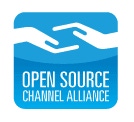Call it D-day for open source channel distribution. Synnex, Red Hat and nearly a dozen open source application providers -- from Alfresco to Zmanda -- have launched the Open Source Channel Alliance. The effort represents a tipping point for open source in the channel, reaching a potential 15,000 Synnex resellers. Here's who's in the Open Source Channel Alliance, who's missing and what it all means to VARs and solutions providers.
April 14, 2009

 Call it D-day for open source channel distribution. Synnex, Red Hat and nearly a dozen open source application providers — from Alfresco to Zmanda — have launched the Open Source Channel Alliance. The effort represents a tipping point for open source in the channel, reaching a potential 15,000 Synnex resellers. Here’s who’s in the Open Source Channel Alliance, who’s missing and what it all means to VARs and solutions providers.
Call it D-day for open source channel distribution. Synnex, Red Hat and nearly a dozen open source application providers — from Alfresco to Zmanda — have launched the Open Source Channel Alliance. The effort represents a tipping point for open source in the channel, reaching a potential 15,000 Synnex resellers. Here’s who’s in the Open Source Channel Alliance, who’s missing and what it all means to VARs and solutions providers.
First, the facts: The Open Source Channel Alliance includes Alfresco, EnterpriseDB, Ingres, Jaspersoft, Likewise, Pentaho, Red Hat, Synnex, Zmanda, Zenoss and Zimbra. The alliance strives to promote open source platforms and applications to roughly 15,000 VARs and solutions providers targeting mid-market customers. Impressive.
Now, a shameless plug: The alliance affirms many of the open source channel trends first identified in The VAR Guy’s Open Source 50 report, which tracks the world’s most promising open source partner programs. All of the initial Open Source Channel Alliance members, excluding Synnex (a distributor), landed in the Open Source 50.
The Big Picture
For many application providers, the Open Source Channel Alliance represents the first time they are working with a major distributor (Synnex) in North America.
For VARs, solutions providers and mid-market customers, the alliance affirms that open source in business has pushed beyond Linux to include middleware, e-mail, databases, content management, business intelligence, backup and other types of open source solutions.
The VAR Guy reached out to many of the initial Open Source Channel Alliance members to see how today’s announcement furthers each company’s partner program. Here’s a closer look at each company’s response.
The Missing Pieces
While promising, the alliance also raises multiple questions.
For starters, the alliance is missing many key open source applications providers — including MySQL, Compiere, Groundwork Open Source, Openbravo, SugarCRM and Untangle — just name a few. MySQL’s absence, in particular, is glaring since so many open source application providers and mid-market customers work closely with that open source database. The VAR Guy has reached out to MySQL for comment.
Synnex says the alliance is “expected to be open to additional open source ISVs in the future.” And Red Hat points out that the alliance is just getting started.
“MySQL is a very good partner of ours, as are the other 3500 ISVs we work with,” said Red Hat’s North American Channel Chief Roger Egan, in a phone chat with The VAR Guy. “This is just the beginning of what we’ll see [involving open source] in the channel.”
Egan says Red Hat’s channel has grown 50 percent-plus quarter over quarter. And in The Open Source 50 report (published December 2008), Red Hat reported that more than half of its revenues came from channel partners. (Here’s a podcast with Egan, in case you need to get to know him.)
Other Penguins as Partners?
Another big question mark: Is the Open Source Channel Alliance open to other Linux providers like Novell or Canonical? “That’s not our call,” says Egan, who defers to Synnex.
Clearly, The VAR Guy needs to pose the same question to Synnex. Our resident blogger is trading voicemail with the distributor. Stay tuned. But it sounds like Novell SUSE Linux, Canonical Ubuntu and other Linux distributions aren’t invited to the Open Source Channel Alliance party.
Still, Novell has distribution relationships in place and Canonical is developing a channel strategy in parallel with the forthcoming Ubuntu 9.04 release, slated for launch later this month.
The bottom line: The Open Source Channel Alliance has some holes, but the overall concept represents a tipping point for open source solutions providers targeting mid-market customers. Sure, Microsoft ISVs remain dominant in the IT channel. And they’re not going away. But open source applications have pushed beyond niche status.
And stay tuned. Related coverage today will include:
Perspectives from other distributors
And plenty more
The VAR Guy is updated multiple times daily. Don’t miss a single post. Subscribe to his newsletter, RSS feed, Twitter feed , Webcasts and Resource Center.
About the Author(s)
You May Also Like


